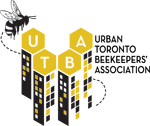Swarms
Honeybee Swarms
You’ve found what you think is a honeybee swarm, let’s make sure. Swarms usually occur on warm sunny days from May to July. Below are some photos of honeybee swarms. The honeybees are clustered, there is no nest material (wax comb) underneath the honeybees.
Honeybee Swarm on a Pick Up Truck
Honeybee Swarm on a Tree Limb
Honeybees building comb
If honeybees have decided to make a home on/in your house or shed they will begin to build honeycomb in which they store honey, pollen and immature bees. Honeybees do not live in the ground or in paper or mud nests.
What should I do if I see a swarm?
A honeybee swarm is a natural part of the honeybee colony lifecycle and is not usually an emergency. In most cases the honeybees will move on in a day or two. Don’t approach the swarm. Although typically honeybees are docile there is always a risk of being stung. Observe from a distance.
Contact the UTBA to have a honeybee swarm relocated. Info@urbantorontobeekeepers.org
Please be ready to supply the following details.
Please take a photo of the swarm
Describe where the swarm is located (30 ft up a tree, in a garbage bin, on a fence)
Physical location (close major intersection)
Date when swarm first noticed
To the right or below is a photo of a hornet nest. Beekeepers do not remove them. You will likely need the services of a licensed pest control professional.
City of Toronto Policy on Wasp Nest Removal
If you are seeing flying black and yellow insects in the fall coming out of a crevice or hole this is not a swarm and may not even be a honeybee. A variety of insects make their homes inside buildings. You may have honeybees, mason bees or they may be wasps. The removal of a colony of insects from behind a wall is specialized work, please contact a licensed pest control professional. It is always valuable to have photographs ready to help identify the insect.
Become A Swarm Catcher
Do you want to be added to the UTBA list of member swarm catchers or members who performs extractions? Members are welcome to submit their information here





